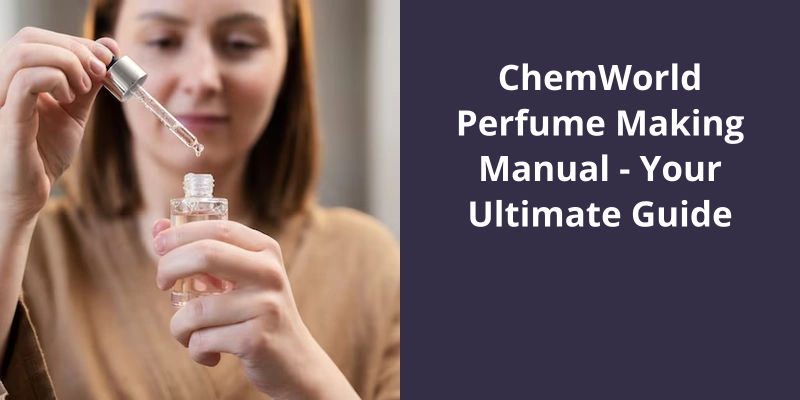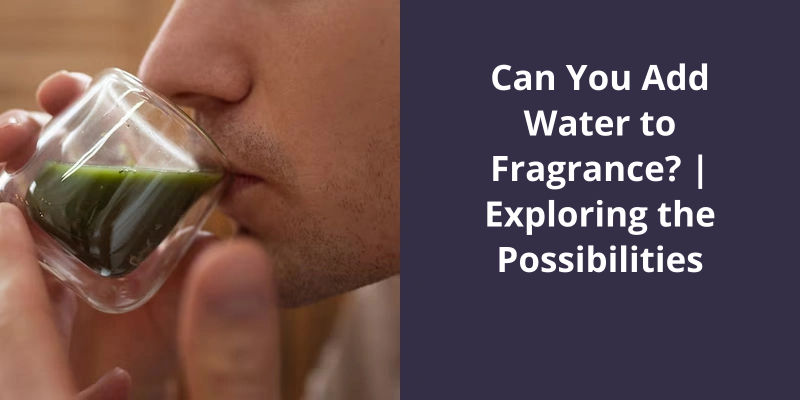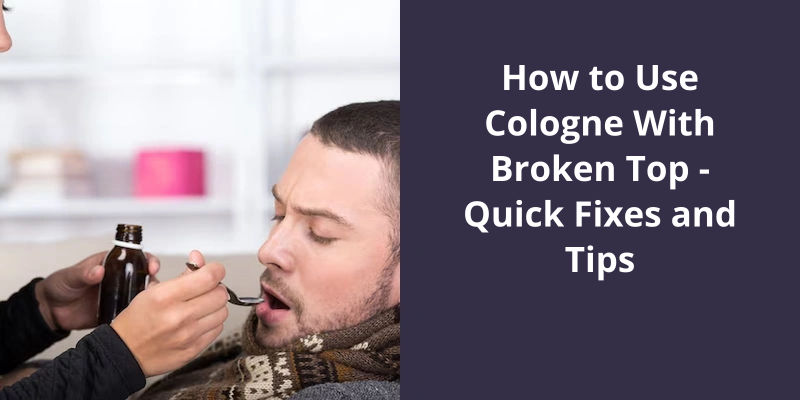The ChemWorld Perfume Making Manual is your ultimate guide to creating your own unique scents. This comprehensive guide provides detailed instructions on how to mix and blend different essential oils to produce different types of perfumes. Not only does it teach the basics of perfume making, but it also dives deep into the science behind scent creation, helping you understand the factors that affect a perfume’s fragrance. Whether you’re a beginner looking to venture into the art of perfume making or a professional wanting to enhance your skills, this manual is a valuable resource.

What Are the Basic Ingredients for Making Perfume?
Perfume is a fragrant liquid made from a mixture of essential oils, alcohol, water, and carrier oils. The art of perfume making dates back to ancient times when the Egyptians and the Romans used various plant extracts to create fragrances. Today, perfume making has evolved into a sophisticated industry that relies on state-of-the-art technologies to create scents that delight our senses.
To make perfume, you need to gather your ingredients carefully. The basic ingredients include carrier oils such as sweet almond, coconut, or jojoba, 100-proof alcohol, bottled water, and essential oils. Youll also need a coffee filter, a small funnel, and two clean dark-glass bottles with airtight lids. Once you’ve your ingredients, you can follow a simple recipe to make your own signature scent.
To create a perfect perfume, start by combining the carrier oil and alcohol in a glass bowl. Then, add the bottled water and stir gently with a spoon. Next, it’s time to add the essential oils. You should add nine drops of top notes, fifteen drops of middle notes, and six drops of base notes. This combination will ensure that your perfume has a pleasant and long-lasting scent.
After adding the essential oils, use the coffee filter to strain the mixture and remove any impurities. The coffee filter will ensure that your perfume is smooth and consistent. Use the small funnel to transfer the perfume into two clean dark-glass bottles with airtight lids. These bottles will help to preserve the quality of your perfume and prevent it from evaporating.
Finally, give your perfume a few days to settle and mature. This will allow the ingredients to blend together and create a well-balanced scent. Once your perfume has had time to mature, you can start using it. You can apply it to your pulse points like your wrists and neck to enjoy it’s fragrance throughout the day. With a little bit of experimentation, you can create a perfume that reflects your personality and style.
Tips for Creating a Balanced Fragrance Blend
- Start with a base note that will be the foundation of the fragrance
- Add a middle note that will give the fragrance character and personality
- Finish with a top note that will be the first thing people smell when they encounter the fragrance
- Use complementary scents that will balance each other out
- Choose scents with different strengths so that one doesn’t overpower the others
- Experiment with different combinations until you find the perfect balance
- Consider the purpose of the fragrance and the intended audience when making your blend
- Keep track of the amounts of each scent you use to reproduce the blend later.
Crafting your very own signature scent may seem intimidating, but it can be a fulfilling and rewarding DIY project. With a few simple steps and the right ingredients, you can create a perfume formula that’s unique to you and reflects your personal style and preferences. So let’s dive in and explore the art of perfume-making!
How Do You Make Perfume Formula?
Perfume making is an art that’s been practiced for centuries. Creating your fragrance formula isn’t just about mixing some oils together. It involves a lot of knowledge and creativity to come up with the perfect scent that suits your personality and preferences.
The first step of making a perfume formula is choosing your carrier oil. Carrier oil is the base for your perfume and helps to dilute the essential oils. Generally, jojoba oil, sweet almond oil, and fractionated coconut oil are the most commonly used carrier oils.
Once you’ve chosen your carrier oil, you need to select your essential oils. Essential oils are the fragrant oils that give perfume it’s unique scent. The essential oils have three different categories: base notes, heart notes, and top notes.
Base notes are the oils that stay on your skin for the longest time, and they help add depth and richness to the fragrance. Heart notes are the oils that add to the body and character of the fragrance, while top notes are the oils that you smell first.
After selecting your essential oils, it’s time to start blending your perfume formula. Using a dropper, add 80 drops of your carrier oil to the perfume bottle. Then, using another dropper for each essential oil, add in 10 drops of your base notes, five drops of your heart notes, and five drops of your head notes.
Once all the oils have been added, seal the bottle tightly and shake it well to distribute the oils evenly.
Finally, label your creation with the name and date you created it. You may want to keep notes, so you remember the recipe you used to create your perfume, to make it easier if you want to recreate it again or make any changes to your scent in the future.
Different Scent Families and How to Choose Essential Oils From Each Family
Essential oils are derived from various plants and come in different scents, also known as scent families. Each family has it’s unique benefits, making it essential to know what you aim to achieve before selecting an essential oil. For instance, the citrus family helps uplift moods and improve focus, while the floral family helps reduce stress and anxiety. Understanding the different scent families enables you to choose essential oils best suited for your needs.
Creating a perfume is a complex process that involves several careful steps. From sourcing the ingredients to perfecting the scent, each stage plays a crucial role in producing a high-quality product that can entice and delight. In this article, we will walk you through the exciting journey of perfume making and explore the key factors that contribute to a successful fragrance.
What Are the Steps in Making Perfume?
Perfume making is an art as it involves the combination of various compounds into a unique scent that’s impossible to replicate. The process of creating a perfume starts with collecting the ingredients. Ingredients play a crucial role in the creation of a fragrance, and each ingredient, whether natural or synthetic, adds it’s own unique scent, thus contributing to the final aroma.
Once the ingredients have been collected, the next step in making perfume is to extract the oils. The extraction process involves collecting oils from natural sources like flowers, fruits, and herbs. The most common extraction methods are steam distillation and solvent extraction. The oils extracted from these ingredients form the base of the perfume, and they’re typically blended with other essential oils and synthetic compounds.
Blending is the next step in the perfume manufacturing process. The art of blending essential oils is the most critical part of fragrance creation. Perfume makers use their expertise to create perfectly balanced blends that complement one another, resulting in a unique scent. During the blending process, each ingredient is measured and mixed to achieve the fragrance desired.
After blending the ingredient, the perfume is aged to allow the ingredients to fully meld and develop into a unique scent. This process can take from a few days to several months, depending on the mixtures complexity.
Finally, the last step in the perfume manufacturing process is quality control. Perfume makers conduct several tests to ensure the formula is consistent and has the desired fragrance. Testing can include physical, chemical, and sensory analysis to determine if the fragrance meets the required standards. Once the perfume has passed all tests and has been bottled and packaged, it’s ready for distribution.
From collecting ingredients to adding final touches, every step is necessary for the creation of a unique scent. With the right blend of essential oils, the right aging techniques, and quality control measures, it’s possible to create a perfume that will be a signature fragrance for it’s user.
Different Types of Ingredients Used in Perfume Making, Their Properties, and Their Effects on the Fragrance.
- Essential oils: They provide the fragrance and are usually natural in origin.
- Alcohol: It acts as a solvent and dilutes the essential oils for ease of application.
- Water: It also acts as a solvent and helps to dilute the alcohol and essential oils.
- Fixatives: These are used to stabilize the fragrance and increase it’s longevity.
- Diluents: Used to decrease the intensity of the fragrance while maintaining it’s structure.
- Solvents: Used to help dissolve the oils and other ingredients and keep them in solution.
- Modifiers: These ingredients add depth and complexity to the fragrance.
- Absolutes: They’re highly concentrated aromatic compounds extracted from plant materials.
- Resins: They’re sticky, fragrant substances obtained from trees and plants.
- Animalic ingredients: These are derived from animal sources, like musk and civet, and add depth and warmth to fragrances.
Source: How Is Perfume Made? – Shay & Blue
Perfume has been used throughout history as a way to enhance one’s scent and leave a lasting impression. While some may assume that all perfumes are made up of artificial and synthetic ingredients, the truth is that many perfume manufacturers still use a range of natural resources to produce high-quality fragrances. From flowers and spices to animal secretions like musk and ambergris, the ingredients used in perfumes can vary widely depending on the desired scent and overall effect. In this article, we will explore the fascinating world of real perfume and examine the ingredients that are typically used in it’s production.
What Is Real Perfume Made Of?
The process of making perfume is an art form that requires a delicate balance of knowledge and creativity. Perfumers must have an in-depth understanding of the properties of each ingredient they use, including it’s scent profile, longevity, and compatibility with other ingredients. This knowledge enables perfumers to craft truly unique fragrances that can evoke emotions and memories in the wearer.
One of the most important factors in crafting a high-quality perfume is the use of natural ingredients. Natural ingredients that are commonly used in perfumes include essential oils, absolutes, and resins derived from plants and flowers. These ingredients provide a wide range of scents, including floral, fruity, spicy, and herbal, and can be used alone or in combination to produce complex and nuanced fragrances.
In addition to natural ingredients, many perfumes also contain synthetic ingredients, which are often used to mimic the scents of natural ingredients. Synthetic ingredients are also used to provide a stable base for the fragrance, helping it to last longer on the skin. While some people may be concerned about the use of synthetic ingredients in perfumes, it’s important to note that these ingredients have been extensively tested for safety and don’t pose any known health risks.
While some perfumes may be mass-produced using cheap synthetic ingredients, others are crafted by master perfumers using only the finest natural ingredients. As such, when shopping for perfume, it’s important to look for a brand that’s known for it’s quality and craftsmanship. By doing so, you can ensure that you’re getting a fragrance that’s truly unique and of the highest quality.
Creating a natural perfume isn’t only better for your health, but it’s also an ethical choice. By opting for a homemade natural perfume, you’ll be saying no to the harmful chemicals and artificial fragrances that are typically added by commercial perfumes. Using essential oils, it’s easy to create your own personalized scent that not only smells great but provides therapeutic benefits too. Here’s how to make a 100% natural perfume.
How Do You Make 100% Natural Perfume?
Making your own 100% natural perfume is easier than you think. While the process may require a bit of experimentation, the end result is a unique scent that you can wear with pride. One of the most popular methods of making natural perfume is by using essential oils. Essential oils are highly concentrated plant extracts that are known for their therapeutic properties.
To make DIY natural perfume oil, you’ll need a carrier oil such as jojoba oil, sweet almond oil, or grape seed oil. Choose your favorite essential oils and start by experimenting with small amounts of each. It’s important to note that essential oils are potent and a little goes a long way. Start with a few drops of each oil and add more until you achieve the desired scent.
One of the most popular essential oils for natural perfume is sweet orange. This oil has a bright and uplifting scent that’s perfect for everyday wear. Combine sweet orange with patchouli for a warm and earthy base note. Lavender can be added for a calming and relaxing effect, while rose geranium adds a floral touch. Ylang ylang is often used in perfumery for it’s sweet and exotic aroma, and bergamot can be added for a fresh and citrusy top note.
When making natural perfume oil, it’s important to remember that the scent won’t be as long-lasting as synthetic perfumes. However, this is a small price to pay for a perfume that’s free of harmful chemicals and is kinder to the environment. Keep your natural perfume in a glass bottle with a tight-fitting lid and store it in a cool, dry place. You can also experiment with different carrier oils and essential oils until you find your perfect scent.
Another benefit of making your own natural perfume is that it can be customized to your personal taste. You can adjust the strength of the scent by adding more or less essential oils. You can also mix and match oils to create different combinations. For example, if you prefer a more floral scent, you could try adding geranium and jasmine essential oils. If you want a more masculine aroma, cedarwood and sandalwood are great options.
The Benefits of Using Natural Perfume
Natural perfume offers several benefits to users. Unlike synthetic fragrances that contain harmful chemicals, natural perfumes are made from plant-based ingredients that are safe for your skin and health. Natural perfumes have a softer scent, making them ideal for people with sensitive skin. Additionally, natural perfume scents tend to be longer-lasting than synthetic fragrances. Using natural perfume can also contribute to environmental sustainability by reducing the use of chemicals and supporting organic farming practices.
Making your own perfume can be a fun and creative process, but it requires some basic knowledge of ratios and measurements to ensure a quality end product. In particular, following a 20% concentration ratio can help ensure that the fragrance is pleasant and long-lasting. Additionally, it’s important to keep track of the ingredients and ratios used in your custom recipe so that you can recreate the scent in the future.
What Ratios Do You Need to Make Perfume?
Making perfume is an art form that requires skill, creativity, and an understanding of the right ratios of ingredients. The concentration ratio for perfumes is typically around 20%, which means that a certain amount of fragrance oil or essential oil will be mixed with a certain amount of carrier oil or alcohol to achieve the desired scent. This concentration ratio is important because it ensures that the perfume will smell strong and last long on the skin.
To determine the right ratios for making perfume, it’s important to know what type of fragrance you want to create. Different scents will require different ratios of ingredients. For example, floral scents will typically require a higher concentration of essential oils, while spicy or woody scents may require more carrier oils to balance out the strength of the fragrance.
When measuring out the ingredients for making perfume, it’s important to be precise. Every milliliter of liquid is roughly 20 drops with a pipette or glass dropper—so for a 5 mL bottle, youll need to account for 100 drops of liquid. This precision will ensure that the ratios are correct and that the perfume will be both effective and enjoyable to wear.
In addition to measuring out the right amounts of fragrance and carrier oils, it’s also important to record the recipe for future use. This will allow you to recreate the scent at a later time, making it easier to fine-tune the recipe or make larger batches of perfume. Keeping accurate records also allows for experimentation with different ratios and combinations of ingredients to create new and unique scents.
By following a 20% concentration ratio and measuring out precise amounts of ingredients, you can create a fragrance that’s both memorable and long-lasting. And don’t forget to record your custom recipe for future use!
Types of Carrier Oils and Their Properties for Fragrance Making
When making fragrances, carrier oils are used as a base for essential oils. There are several types of carrier oils, including almond, coconut, jojoba, and grape seed oil. Each carrier oil has it’s own unique properties that can affect the fragrance’s scent, longevity, and texture. For example, almond oil is light and absorbs quickly, while coconut oil is heavier and solid at room temperature. Choosing the right carrier oil is important for creating a well-balanced fragrance.
Conclusion
It breaks down the chemistry and composition of fragrance oils, essential oils, and aroma chemicals, while also exploring the different fragrance families and their characteristics.





